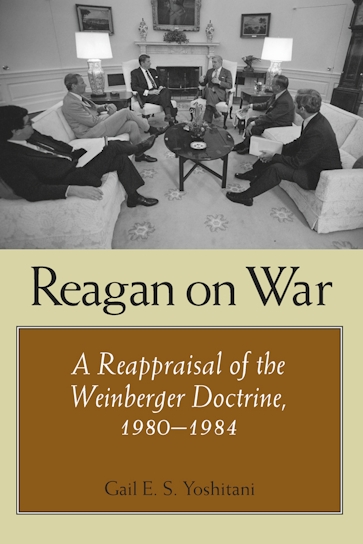Reagan on War
A Reappraisal of the Weinberger Doctrine, 1980-1984
978-1-60344-259-6 Cloth
6 x 9 x 0 in
272 pp. 11 b&w photos. Bib. Index.
Pub Date: 12/15/2011
Available
Even at the time it was announced near the end of the first term of the Reagan administration, such luminaries as William Safire mischaracterized the Weinberger Doctrine as a conservative retreat from the use of force in U.S. international relations. Since that time, scholars have largely agreed with Safire that the six points spelled out in the statement represented a reaction to the Vietnam War and were intended to limit U.S. military action to “only the fun wars” that could be relatively easily won or those in response to direct attack.
In this work of extensive original scholarship, military historian Gail Yoshitani argues that the Weinberger Doctrine was intended to legitimize the use of military force as a tool of statecraft, rather than to reserve force for a last resort after other instruments of power have failed. This understanding sheds much clearer light on recent foreign policy decisions, as well as on the formulation and adoption of the original doctrine.
With the permission of the family of former Defense Secretary Caspar Weinberger, Yoshitani gained access to Weinberger’s papers at the Library of Congress. She is the first scholar granted access to General (ret.) John Vessey’s archive at the Library, and her security clearance has made it possible for her to read and use a large number of materials still classified as secret or top secret.
Yoshitani uses three case studies from the Reagan administration’s first term in office—Central America and two deployments in Lebanon—to analyze how the administration grappled with using military force in pursuit of national interests. Ultimately, the administration codified the lessons it learned during its first term in the Weinberger Doctrine promulgated by Secretary of Defense Weinberger in a speech on November 28, 1984, two weeks after Reagan won reelection in a landslide. Yoshitani carefully considers the Weinberger Doctrine’s six tests to be applied when considering the use of military force as a tool of statecraft.
Just as the Reagan administration was forced to dance an intricate step in the early 1980s as it sought to use force as a routine part of statecraft, current and future administrations face similar challenges. Yoshitani’s analysis facilitates a better understanding of the Doctrine and how it might be applied by American national security managers today.
This corrective to the common wisdom about the Weinberger Doctrine’s goals and applicability to contemporary issues will appeal not only to diplomatic and military historians, but also to military leaders and general readers concerned about America’s decision making concerning the use of force.
Foreign Relations and the Presidency
About the Author
Reviews
Published by Texas A&M University Press
